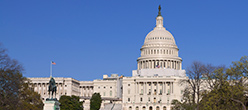Current initiatives

The Postal Service is undergoing a significant transformation that will modernize our delivery, processing, and transportation network and evolve to what our customers need and value, and thereby thrive into the future. There is an unprecedented urgency and purpose to our action. Delivering for America (DFA) is a transformational roadmap to building operational excellence, financial stability, and a sustainable future for this essential national institution. Since we launched DFA in 2021, we have a mission to improve service, efficiency, and our financial outlook, all while building a new USPS that continues to meet our universal service mission to deliver mail and packages six and seven days a week.
We are now seeing results. For example, during the 2023 Peak Holiday Season, we delivered over 50 percent of mail and packages ahead of schedule, and 98 percent of Americans received their mail and packages within three days. We achieved this performance with fewer planes, trucks, buildings, and workhours than last year, despite higher package volume. Furthermore, our projected losses for the decade have been reduced by more than half — from $160 billion to $70 billion.
It is paramount that we do not lose the momentum built over the past three years by our organization, and with bipartisan help from Congress, through enactment of the Postal Service Reform Act. We are correcting for 15 years of inadequate responses to changing times, a defective pricing model, and the damage inflicted on this organization by the tired thinking of the past. We must adopt the bold organizational, operational and market strategies in DFA that will change the trajectory of the Postal Service.
Together, we need to act courageously, decisively, and immediately to fix the Postal Service, and we are already confident that the Delivering for America Plan has proven itself to be the rational roadmap for doing so. We are working diligently to implement the current initiatives:
Network Modernization: The Postal Service is now investing $40 billion in modernization, including a network formed around Regional Processing and Distribution Centers (RPDCs), Local Processing Centers (LPCs), and Sorting and Delivery Centers (S&DCs). This new model establishes a much more logical, reliable, consistent, precise, and efficient network to improve service and competitive posture.
While these investments are a major undertaking, these “middle mile” processing plant changes will be behind-the-scenes and the typical postal customer will be completely unaware they are happening.
RPDCs are strategically important for our modernization. They will act as multi-functional distribution centers for all network originating mail and packages and all destinating packages — effectively centralizing all metro-area originating processing operations in a single building, with crossdocking and other functionality as required in the specific region. Our RPDCs will serve as package powerhouses with state of-the-art equipment.
LPCs are designed to connect RPDCs to delivery operations with the primary mission of sorting letter and flat mail to carrier route or delivery walk sequence and serving as a transfer center to aggregate product on its way to delivery.
Furthermore, we have targeted key markets where we can aggregate delivery units and carrier routes into fewer, larger, centrally located Sorting and Delivery Centers (S&DCs) — leveraging both repurposed and new facilities — to provide faster and more reliable mail and package delivery over a greater geographic area. This S&DC network will optimize delivery in our busiest markets and remove many of the impediments that currently slow down our operations.
Network Modernization Improvements Include:
- Larger, more efficient delivery unit designs.
- Improved service performance and reliability.
- Ample space, docks, conveyors, and material handling equipment to operate more efficiently.
- Improved employee work environments and morale.
- Reduced transportation costs.
- Logically sequenced workflow connecting facilities and mail to customers.
- Reduced carbon footprint through electric vehicles, fuller trucks, and fewer trips.
A Modern and Green Postal Fleet: Through the Next Generation Delivery Vehicle (NGDV) Program, we are working to replace our outdated and unsafe 30-year-old delivery fleet with purpose-built vehicles and Commercial-Off-The-Shelf (COTS) that will maximize efficiency, deliver advanced vehicle and safety technology, and increase cargo capacity.
The Postal Service plans on procuring a total of 21,000 COTS EVs. In addition, the Postal Service anticipates adding at least 45,000 battery-electric NGDVs by 2028, bringing the total number of EVs in the delivery fleet to more than 66,000.
While the majority of funding for electric vehicles will continue to be from postal funds, in 2022 Congress appropriated $3 billion dollars which has helped to jumpstart electrification by covering initial charging infrastructure costs and a portion of electric vehicle purchase cost over the next 5 years. The Inflation Reduction Act (IRA) funds for electrification of the fleet are expected to be entirely expended by 2028.
New and Enhanced Product Offerings: The Postal Service is modernizing our product and service offerings to take advantage of the growth in the package market and consumer trends.
USPS Connect — USPS Connect is a new set of four affordable delivery solutions to help American businesses meet growing consumer demand for fast delivery. The solutions capitalize on ongoing network improvements, new processing equipment, and increased operational precision to enhance our business customer offerings and improve service across the country. We are rolling out USPS Connect in phases, nationwide. To learn more, visit https://www.uspsconnect.com/.
USPS Ground Advantage — USPS Ground Advantage streamlines and simplifies package shipping options for customers and enhances the Postal Service’s ground product offering with the anticipated summer 2023 launch. USPS Ground Advantage will feature two-to five-day service standards for packages up to 70 pounds.













